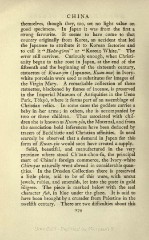Page 340 - Oriental Series Japan and China, Brinkly
P. 340
CHINA
themselves, though they, too, set no light value on
good specimens. In Japan it was from the first a
strong favourite. It seems to have come to that
country originally from Korea, an accident that led
the Japanese to attribute it to Korean factories and
to call it "Haku-gorai" or "Korean White." The
error still survives. Curiously enough, when Christi-
anity began to take root in Japan, at the end of the
fifteenth and the beginning of the sixteenth century,
statuettes of Kwan-yin (Japanese, Kuan-non} in Ivory-
white porcelain were used as substitutes for images of
Athe Virgin Mary.
remarkable collection of these
statuettes, blackened by fumes of incense, is preserved
in the Imperial Museum of Antiquities in the Ueno
Park, Tokyo, where it forms part of an assemblage of
Christian relics. In some cases the goddess carries a
baby in her arms in others, she is accompanied by
;
two or three children. Thus associated with chil-
dren she is known as Kwan-yin, the Maternal, and from
the association bold inferences have been deduced by
tracers of Buddhistic and Christian affinities. It need
scarcely be observed that a demand in Japan for this
form of Kwan-yin would soon have created a supply.
Solid, beautiful, and manufactured in the very
province where stood Ch'iian-chou-fu, the principal
mart of China's foreign commerce, the Ivory-white
Chien-yao naturally went abroad in considerable quan-
tities. In the Dresden Collection there is preserved
a little plate, said to be of this ware, with uncut
jewels, rubies, and emeralds, let into the paste in gold
filigree. The piece is marked below with the seal
character fuh, in blue under the glaze. It is said to
have been brought by a crusader from Palestine in the
twelfth century. There are two difficulties about this
274

